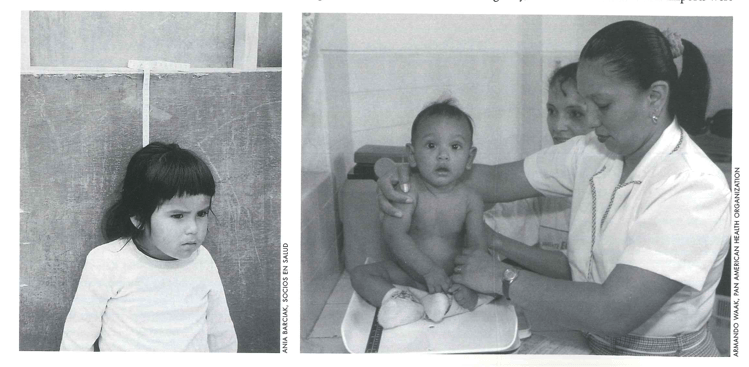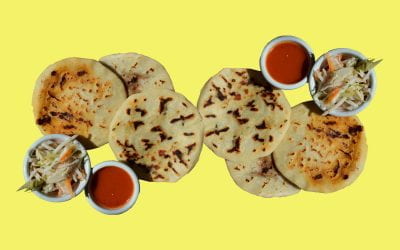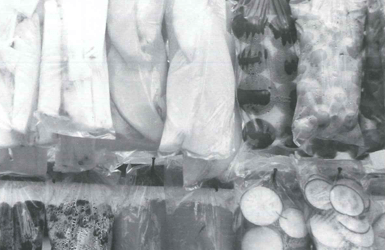What Food? Who Eats It? Why Does It Matter?
Food for Thought

Left: girl being measured; right child being weighed in clinic.
Searching for food together with growing, cooking, and eating it has consumed more time than any human activity except sleeping for most of human history. Curiously, historians have never devoted as much attention to the feeding of multitudes as they have to the ceremonial and predatory behavior of tiny minorities. And even so, we often seem to know much more about the symbols and rituals of power than about what the powerful had for supper (or about the folks whose labor fed them).
The history of agriculture and nutrition the food history of Latin America makes fascinating reading. It begins with the migration of hunters, gatherers, and fishers from northern Asia during the last Ice Age, which ended about 12,000 BCE. It includes the late transition to sedentary agriculture – about 3,000 BCE or so in the New World versus 9,000 in the Fertile Crescent of the Middle East. New World populations took longer to develop agriculture in part because the more abundant wildlife in relation to humans made hunting, gathering, and fishing more productive for a longer time. Another reason is that trial-and-error genetic engineering was much more difficult to accomplish with the wild plants (like maize and potatoes) of the New World than with the food grains developed in the Old. Moreover, agriculture had to wait until humans migrated to the mineral-rich soils of mountain valleys and plateaus, away from the quickly exhausted soils of the tropical lowlands where fish and game had been more abundant.
When the Spanish conquerors arrived in the New World, they found that the agriculture supporting the great cities and states of Mesoamerica differed from that of the Andes. In Mexico and Central America, maize (corn) and beans (frijol) constituted the staples of a diet that also included squash, hot peppers (chiles), and a variety of other fruits and vegetables unknown in Europe. In the Andes, they found a more diverse agriculture in which potatoes and other root crops often predominated. The Andean diet did not include the large number and variety of chiles found in Mexico, but included more animal protein. Mesoamerica had no domesticated animals — horses and camels probably originated in the New World, but died out during the same Ice Age that brought in humans. In South America, however, the indigenous peoples domesticated the surviving camelid species: alpacas, llamas, and vicuñas.
In the aftermath of the Spanish and Portuguese conquests and colonization of the New World, a “Columbian Exchange” of plants and animals took place on a large scale. Tragically, the first of the Old World imports were microscopic in size but catastrophic in their impact. Smallpox, pneumonia, influenza, and many diseases unknown in the New World literally killed millions as pathogens spread throughout the hemisphere. Historical demographers place the pre-Conquest Native American population at 50-70 million. From 1492 to the early 1600s, the population fell to less than five million.
Meanwhile, a vast transformation of diets had begun in the Old Word as well as the New. Since the Old World produced some 500 of the 640 domesticated plants and 12 of the 14 domesticated animal species developed by humans up to 1492, biodiversity increased more in the New World than in the Old. The Old World supplied food grains (wheat, barley, rye, oats), chickpeas, melons, onions, cabbages, cauliflowers, olives, radishes, orchard fruits of all kinds (apples, peaches, bananas, oranges and lemons), grapes, rice, and sugar cane. Even more significant (and at times destructive) were the animals: sheep, cattle, horses, donkeys, pigs, goats, and chickens.
The New World foods that reached the Old were fewer in number, but they spread widely and some became dietary staples in vast areas. Chief among the New World crops adopted by the Old were maize (corn), many varieties of beans, potatoes, yams, tomatoes, peanuts, coffee, cacao, tobacco, manioc, squashes, and rubber.
Major portions of the “authentic” and “native” cuisines of both the Old World and the New consist of foods that only penetrated local diets long after the dietary globalization touched off by the voyages of Columbus.
We know much less about the history of agricultural productivity and nutrition until recent times. What evidence there is suggests that both output and nutrition levels were low by European standards among the sedentary agriculturalists of the New World, especially in central Mexico. As in other agricultural populations, those of the New World combined low levels of nutrition with correspondingly low levels of exertion. Subjection to Old World work rhythms probably increased the mortality rates. Only the lucky few who survived the pandemics benefited from the increase in agricultural productivity that resulted from new food sources and the sometimes forced resettlement of rural populations away from marginal areas and onto the most productive lands.
Most governments did not start collecting data on income distribution or poverty until sometime in this century. For earlier centuries, historians now use data on the average (mean) height or stature of a population. Stature provides an excellent measure of “net nutrition,” that is, total or gross nutrition minus what is needed to ward off disease and work for a living. This is because human stature at equal levels of net nutrition does not vary from one racial or ethnic group to another (even though individual height can vary).
The widespread myth in Latin America that indigenous peoples are genetically shorter than Europeans or mestizos is false. Differences in height between population groups are due mainly to differences in net nutrition, especially in the first three years of childhood and during adolescent growth spurts. Where children and adolescents are exposed to more disease, lack access to adequate medical care, or engage in stressful or strenuous work, more nutrition is needed to achieve the same stature.
Differences in the stature of racial, ethnic, and social groups in Latin America, like anywhere else, are mainly attributable to differences in net nutrition. Such differences used to be common in today’s developed countries. In 1800, the titled nobility of England stood a full five inches taller than the English population as a whole. Today, the difference is less than one inch and scarcely noticeable. Aristocrats and commoners are both taller today than in 1800, but the benefits of better diet were concentrated at the lower end of the income scale.
In 1800, the English population consumed a little more than 2,000 calories per day, slightly less than the average for Latin America today. At this level, historians have estimated that roughly 20 percent of the adult population was too malnourished to work. Of the 80 percent available for work, most could not have worked at anything like the intensity of the modern workplace.
Improved nutrition helped fuel the British economy. Economic historian Robert William Fogel, in his Nobel Prize Lecture in 1994, estimated that 30 percent of the increase in the per capita product of Great Britain between 1790 and 1980 was due solely to improvements in gross nutrition. Improvements in public health and access to medical care made additional contributions to growth by enabling people to use more calories for work because they needed fewer to fight disease.
In contrast, many contemporary Native-American farmers in Mesoamerica and the Andes continue to survive at nutrition levels close to that of the conquest era. Though life expectancy on average has increased from less than 40 years to over 70 in most of Latin America, the health and nutrition statistics for indigenous and other marginalized groups have lagged behind. In Mexico, for example, the average height of indigenous villagers in some areas in the south of the country, is comparable to that of the pre-Conquest era. The same is true in some highland areas of the Andes.
Throughout Latin America, despite enormous advances in agricultural technology and technique, nutrition levels for entire countries and regions are so low that physical stature, ability to work a full day or at modern levels of intensity, and even intellectual capacities are severely compromised. The United Nations Development Programme, citing government statistics, reports that the average caloric intake of the region as a whole is close to 2700 per day (versus 3600 in the United States), but less than 1900 in Peru and Haiti, 2100 in Bolivia and Panama, and 2300 in Honduras, Guatemala, and Nicaragua. In other countries, such as Brazil and Mexico, regional disparities income have left large areas in similar condition. Malnutrition and poor nutrition is exacerbated by inequality, poor or absent health care, and the high incidence of preventable diseases due to poor sanitation.
At such low levels of nutrition, substantial numbers of adults are unable to work full time or as intensively as modern economies require. Among the 38 percent of the Latin American population classified as “poor,” that is, with a daily income equivalent to less than two U.S. dollars, malnutrition and undernourishment are widespread. The risk to children is also particularly high among such populations.

Some programs rely on distribution food or food certificates to low income families.
Efforts to alleviate nutrition deficits in Latin America have varied in design and effectiveness. Some programs, such as Mexico’s Progresa, concentrate on the poorest citizens and provide a variety of services and subsidies. Others attempt to reach larger population groups, but with fewer resources per person. Policy analysts and administrators are constantly searching for ways to enhance the impact of the limited resources devoted to such efforts. Some programs rely on distributing food or food certificates to low income families, like the food stamp program in the United States. Others rely on broader schemes involving welfare payments, job-creation, or school-related benefits. In some cases, programs have emphasized health and nutrition education, though such efforts risk failure where family incomes are not sufficient to purchase better balanced diets. None have proved adequate to the magnitude of Latin America’s problems in this area.
For the foreseeable future, it appears, Latin America is not likely to achieve more than gradual improvements in overall nutrition as the benefits of economic growth and modest government programs trickle down. Slower growth, as in the stagnant decade of the 1980s, or in the recession just underway now, reverse progress and increase the nutrition deficit affecting much of the region’s population. Until both political will and adequate resources can be found, Latin America’s economic modernization will remain stunted by the lost productivity of much of the region’s undernourished population.
Spring/Summer 2001
John H. Coatsworth is the Monroe Gutman Professor of Latin American Affairs and director of the David Rockefeller Center for Latin American Studies.
Related Articles
Salvadoran Pupusas
There are different brands of tortilla flour to make the dough. MASECA, which can be found in most large supermarkets in the international section, is one of them but there are others. Follow…
Salpicón Nicaragüense
Nicaraguan salpicón is one of the defining dishes of present-day Nicaraguan cuisine and yet it is unlike anything else that goes by the name of salpicón. Rather, it is an entire menu revolving…
The Lonely Griller
As “a visitor whose days were numbered” in Buenos Aires, Argentina, he tossed aside dietary restrictions to experience the enormous variety of meat dishes, cuts of meat he hadn’t seen…



